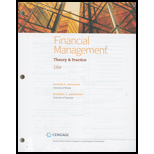
Start with the partial model in the file Ch20 P08 Build a Model.xlsx on the textbook’s Web site. Maggie’s Magazines (MM) has straight nonconvertible bonds that currently yield 9%. MM’s stock sells for $22 per share, has an expected constant growth rate of 6%, and has a dividend yield of 4%. MM plans on issuing convertible bonds that will have a $1,000 par value, a coupon rate of 8%, a 20-year maturity, and a conversion ratio of 32 (i.e., each bond could be convertible into 32 shares of stock). Coupon payments will be made annually. The bonds will be noncallable for 5 years, after which they will be callable at a price of $1,090; this call price would decline by $6 per year in Year 6 and each year thereafter. For simplicity, assume that the bonds may be called or converted only at the end of a year, immediately after the coupon and dividend payments. Management will call the bonds when their conversion value exceeds 25% of their par value (not their call price).
- a. For each year, calculate (1) the anticipated stock price, (2) the anticipated conversion value, (3) the anticipated straight-
bond price , and (4) the cash flow to the investor assuming conversion occurs. At what year do you expect the bonds will be forced into conversion with a call? What is the bond’s value in conversion when it is converted at this time? What is the cash flow to the bondholder when it is converted at this time? (Hint: The cash flow includes the conversion value and the coupon payment, because the conversion occurs immediately after the coupon is paid.) - b. What is the expected
rate of return (i.e., the before-tax component cost) on the proposed convertible issue? - c. Assume that the convertible bondholders require a 9% rate of return. If the coupon rate remains unchanged, then what conversion ratio will give a bond price of $1,000?
Want to see the full answer?
Check out a sample textbook solution
Chapter 20 Solutions
FINANCIAL MANAGEMENT(LL)-TEXT
- Question 25 Jasmine bought a house for $225 000. She already knows that for the first $200 000, the land transfer tax will cost $1650. Calculate the total land transfer tax. (2 marks) Land Transfer Tax Table Value of Property Rate On the first $30 000 0% On the next $60 000 0.5% (i.e., $30 001 to $90 000) On the next $60 000 1.0% (i.e., $90 001 to $150 000) On the next $50 000 1.5% (i.e., $150 001 to $200 000) On amounts in excess of $200 000 2.0% 22 5000–200 000. 10 825000 2.5000.00 2 x 25000 =8500 2 maarrow_forwardQuestion 25 Jasmine bought a house for $225 000. She already knows that for the first $200 000, the land transfer tax will cost $1650. Calculate the total land transfer tax. (2 marks) Land Transfer Tax Table Value of Property Rate On the first $30 000 0% On the next $60 000 0.5% (i.e., $30 001 to $90 000) On the next $60 000 1.0% (i.e., $90 001 to $150 000) On the next $50 000 1.5% (i.e., $150 001 to $200 000) On amounts in excess of $200 000 2.0% 225000–200 000 = 825000 25000.002 × 25000 1= 8500 16 50+ 500 2 marksarrow_forwardSuppose you deposit $1,000 today (t = 0) in a bank account that pays an interest rate of 7% per year. If you keep the account for 5 years before you withdraw all the money, how much will you be able to withdraw after 5 years? Calculate using formula. Calculate using year-by-year approach. Find the present value of a security that will pay $2,500 in 4 years. The opportunity cost (interest rate that you could earn from alternative investments) is 5%. Calculate using the formula. Calculate using year-by-year discounting approach. Solve for the unknown in each of the following: Present value Years Interest rate Future value $50,000 12 ? $152,184 $21,400 30 ? $575,000 $16,500 ? 14% $238,830 $21,400 ? 9% $213,000 Suppose you enter into a monthly deposit scheme with Chase, where you have your salary account. The bank will deduct $25 from your salary account every month and the first payment (deduction) will be made…arrow_forward
- PowerPoint presentation of a financial analysis that includes the balance sheet, income statement, and statement of cash flows for Nike and Adidas. Your analysis should also accomplish the following: Include the last three years of data, and evaluate the trends in the data. Summarize the footnotes on each of the statements. Compute the earnings per share for the three years. Compare the two companies and determine the insights gathered from the trend analysis.arrow_forwardIn addition to the customer affairs department of the insurance company the insurance policy must identify which other following on the policy Name of the producer Current director of insurance Policyholder satisfaction rating for paying claims 4. Financial rating from a recognized financial rating servicearrow_forwardIn addition to the customer affairs department of the insurance company the insurance policy must identify which other following on the policy Name of the producer Current director of insurance Policyholder satisfaction rating for paying claims D. Financial rating from a recognized financial rating servicearrow_forward
- Unearned premium refunds for insurance policies cancelled when an insurance company is covered by the Illinois Insurance guaranty fund is subject to a MAXIMUM premium refund of what amount? A.$ 100.00 B.$ 1000.00 C.$10,000.00 D.$ 100,000.00arrow_forwardBefore the department of insurance can issue an order charging an insurance company with improper claims practices, they must first: Review the company's financial statement on file with the department Determine that the practice has been done with such frequency as to indicate a business practice Contact the company's competitors to determine if they know how the company operates Contact the NAIC to determine if the company is on the watch listarrow_forwardthe last three (3) years of the EPS and a summary of the footnotes for Nike and Adidas.arrow_forward
